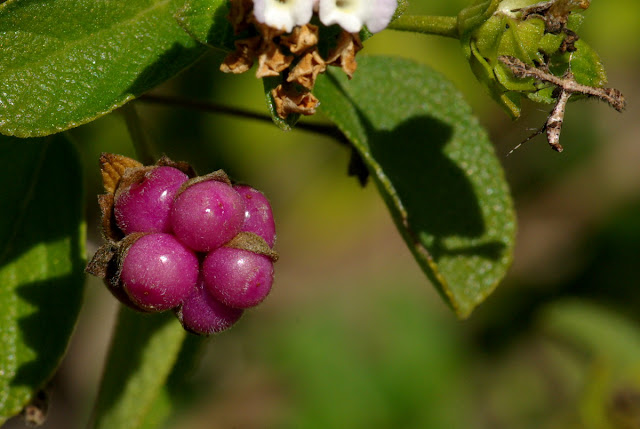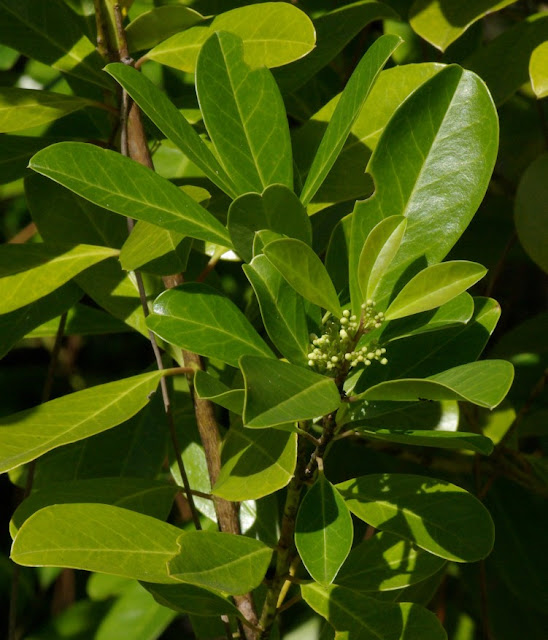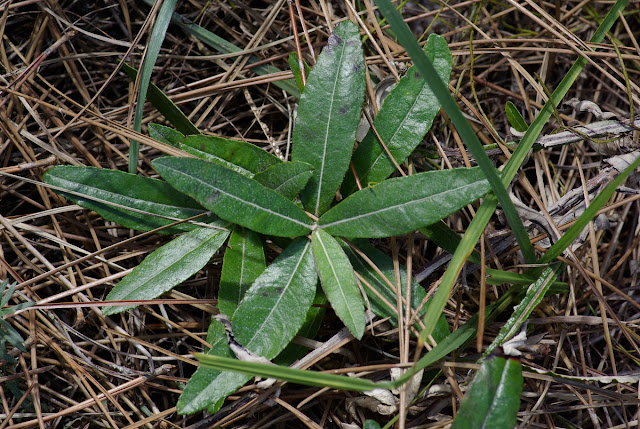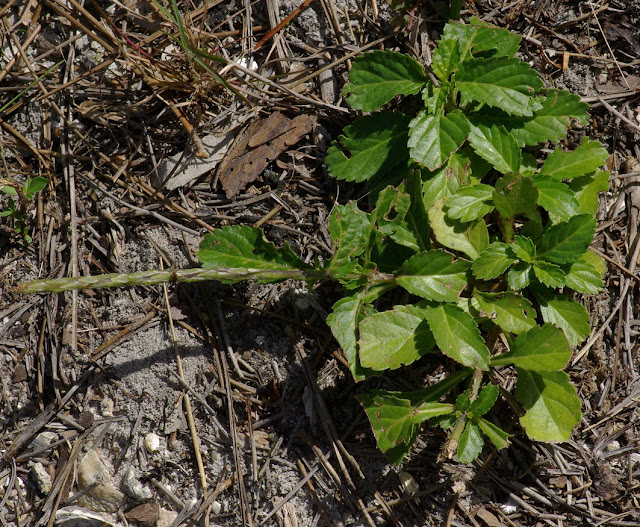This is the second part of my photographic tour of the Okeeheelee County Park Nature Center, which I visited on Friday, December 23, 2011. In the
first part, I focused on the butterfly garden that surrounds the perimeter of the nature center building. In this second part, I will focus on the plants observed while on the nature trails in the eastern portion of the nature center. The map below shows my route and the numbers correspond to the general location of the numbered entries in this post. The meeting pavilion is labeled No. 1; the nature center building is not visible but it lies a short distance south and west of point No. 2.
 |
| Map imagery ©2011 GeoEye; map data ©2011Google. |
Point No. 2 is a very interesting site with many square yards dominated by bracken, Pteridium aquilinum, which is the largest fern native to Palm Beach County. Growing at the periphery of the bracken colony, or sometimes growing with the bracken, are a variety of common native and non-native plants characteristic of disturbed habitats. Some of these include rosary pea, American beautyberry, poison-ivy, Caesar weed, and common tick-trefoil.
 |
| The densest portions of the bracken colony are a near monoculture of bracken. |
 |
| A close-up of the foliage of the bracken. Note the grape leaf in the lower right hand corner. |
 |
| Abrus precatorius, rosary pea, is a common invasive pest plant throughout the Okeeheelee County Park Nature Center. Like most non-native pest plants, it has little wildlife value and the conspicuous black and red seeds fool birds into thinking they are eating a juicy berry but they pass undigested without having provided any nutrition to the bird. |
 |
| Callicarpa americana, American beautyberry, is a tough nearly indestructible native shrub and here we see it thriving while competing with bracken and wild grape. |
 |
| Toxicodendron radicans, poison-ivy, is a common plant throughout much of the Okeeheelee County Park Nature Center and is often afflicted with unusual pink galls, these caused by the poison-ivy leaf gall mite, Aculops rhois, a microscopic eriophyid mite. |
 |
| Urena lobata, Caesar weed, was originally introduced from east Asia, probably India, as a source of fiber. Due to superior sources of fiber, it is not profitably grown in the United States and it has escaped to become an invasive pest. The small, pretty flowers are borne by a large coarse plant and they are soon followed by unattractive, dry brown fruits that split into five segments that are covered with hooked bristles by which means they tenaciously cling to clothing. |
 |
| Desmodium incanum, common tick trefoil, is a common weed of lawns, roadsides, vacant lots, and the disturbed portions of natural areas. It was orginally native to the American tropics but now has a pantropical distribution due to dispersal by human activity. |
Following the trail to the east, one soon encounters highly disturbed areas along the trail at Point No. 3. Typical of such areas, and one of Palm Beach County's most common native weeds, is the common wireweed or common fanpetals. It is in the mallow family and there is scarcely an empty urban lot in Palm Beach County in which it does not occur.
 |
| Sida ulmifolia, common wireweed or common fanpetals, is often found in older works under the synonym, Sida acuta. |
At Point No. 4, one can find button-sage, which is a lantana and not a true sage, and yellow-alder. Neither occurs naturally at Okeeheelee County Park Nature Center and both have escaped after being cultivated at Point No. 1 (the meeting pavilion). I also found a plant of varnish leaf, Dodonaea viscosa, a few yards from Point No. 4, it being yet another example of a plant escaping after being cultivated at the nature center.
 |
| Lantana involucrata, button-sage, has pretty tricolored flowers marked with lavender-pink, white, and yellow. It is frequently grown as a nectar plant in butterfly gardens. Although native to the region, it does not naturally occur at the nature center and the plants at Point No. 4 represent escapes from cultivation. |
 |
| Lantana involucrata, button-sage, has tiny but conspicuous amethyst berries that resemble miniature versions of beautyberry (Callicarpa americana). Note the tiny moth in the upper right hand side of the image. |
 |
| Turnera ulmifolia, yellow-alder, is a non-native plant that was cultivated at the meeting pavilion but has escaped and is growing wild about 25 yards away. Note the foliage of the invasive pest plant, rosary pea (Abrus precatorius), in the background. In the upper right hand corner, one can see the foliage of Chromolaena odorata, and in the lower left hand corner, a single leaf of an unidentified Smilax species is visible. |
Points Nos. 5 and 6 puts us in a region of very dry pine flatwoods, as is attested to by the presence of prickly-pear.
 |
| Opuntia humifusa, prickly-pear, is represented by only a few plants in the driest portions of the eastern section of the nature center. Long ago, rescued gopher tortoises were released at the Okeeheelee County Park Nature Center and there is a possibility that the prickly-pears were established from seeds defecated by these rescued gopher tortoises. |
 |
| Mitracarpus hirtus, small squareweed or white eye, is a small non-native annual weed confined to the dry pine flatwoods in the eastern section of the nature center. The plants, which number perhaps a few dozen, have been present for well over a decade with the population seemingly never decreasing or increasing. The pictured plant is about 2 inches tall, with the largest plants reaching about 5 inches or so. |
 |
| Vitis rotundifolia, muscadine or wild grape, is a common vine throughout the nature center. In the dry pine flatwoods of the nature center, it is a small sprawling vine. With more moisture, it can become a tall, woody liana that can grow into the canopy of the tallest trees. |
Point No. 7 is a small excavated pit that is very old and has become a pond with a very diverse wetland flora. The County Parks decided to "improve" the area and contracted with a nursery to plant bald-cypress, Taxodium distichum, and red maple, Acer rubrum along the southern edge of the pond. There were two problems with this: (1) the cypress native to the Okeeheelee County Park Nature Center is pond-cypress, Taxodium ascendens, and bald-cypress is non-native, at least within the boundaries of the nature center and (2) the nursery that installed the plants was infested with the invasive pest plant, Sphagneticola trilobata, and this undesirable plant was inadvertently introduced into the site along with the bald-cypress and red maple. A further improvement was made to this small pond by the construction of a visitor bench at the pond's southeast corner. Unfortunately, the bench was placed at the edge of a tiny seep that held the nature center's only populations of pink sundew, Drosera capillaris, and lanceleaf violet, Viola lanceolata. I have not seen either plant since the installation of the bench and presume that they were extirpated from the resulting disturbance to the seep.
 |
| Dahoon holly, Ilex cassine, was blooming in late December, which I thought might be a peculiarity of this one population; however, since my visit to the Okeeheelee County Park Nature Center, I have seen it in flower in other natural areas in Palm Beach County, therefore such early flowering does not appear to be particularly unusual. Dahoon holly is an extremely handsome plant as can be seen from the beautiful, glossy green leaves. It is even more attractive in the autumn and winter when female trees are laden with quantities of brilliant red berries. Although often associated with moist soil, it is remarkably adaptable and readily takes to average garden conditions and will even survive considerable drought. |
 |
| An unidentified bog button, Lachnocaulon species, was characteristic of the drier, but still moist, upper slope of the pond. |
Point No. 8, my last stop on this late winter tour of the Okeeheelee County Park Nature Center, takes us to the northwestern corner of the dry flatwoods at the eastern portion of the nature center.
 |
| Blackroot, Pterocaulon pycnostachyum, has stems that arise from dark brown or black tubers, thus accounting for the common name. The subterranean tubers allow the plant to easily survive both fires and droughts and, although the aerial portions of the plant may die, new shoots soon arise from the tubers when conditions improve. The lower surface of the leaves are creamy white due to an extremely dense coat of very fine white hairs. The leaves are thus similar to those of sunbonnets, Chaptalia tomentosa, another plant that has dark green leaves with a lower surface densely covered with white hairs. |
 |
| Blue porterweed, Stachytarpheta jamaicensis, is native to the south of our area in Miami-Dade and Monroe counties. At the Okeeheelee County Park Nature Center, it occurs mostly along the gravelly trail in the vicinity of Map Point No. 8. One or two plants were introduced to this site by a volunteer at the nature center and there is now a small colony of several dozen plants. After well over a decade, the colony has not spread further and the plants appear, to the casual untrained eye, to be just another component of the natural flora. Blue porterweed is often confused with the nettle-leaf porterweed, Stachytarpheta cayennensis (synonym: Stachytarpheta urticifolia), but blue porterweed is distinguished by its sprawling stems that never grow upright with the plants rarely exceeding about 1.5 feet in height (not including the long flower spikes). |
 |
| And here is an image of a cultivated blue porterweed, Stachytarpheta jamaicensis, looking very different from the same species as it grows wild at the Okeeheelee County Park Nature Center. Like most native plants, it is extremely responsive to even a little extra watering and soil fertility. |
Images and text © 2011, 2012 Rufino Osorio, all rights reserved (exclusive of the aerial Google map).




















1 comment:
I got to this site when I googled the pink gall on the poison ivy, but I stayed to read every bit of it. Very nice! Wish I could visit someday from western MA. Love the information about each plant. I'd love to see a similar site about each of the nature centers that I frequent.
Post a Comment